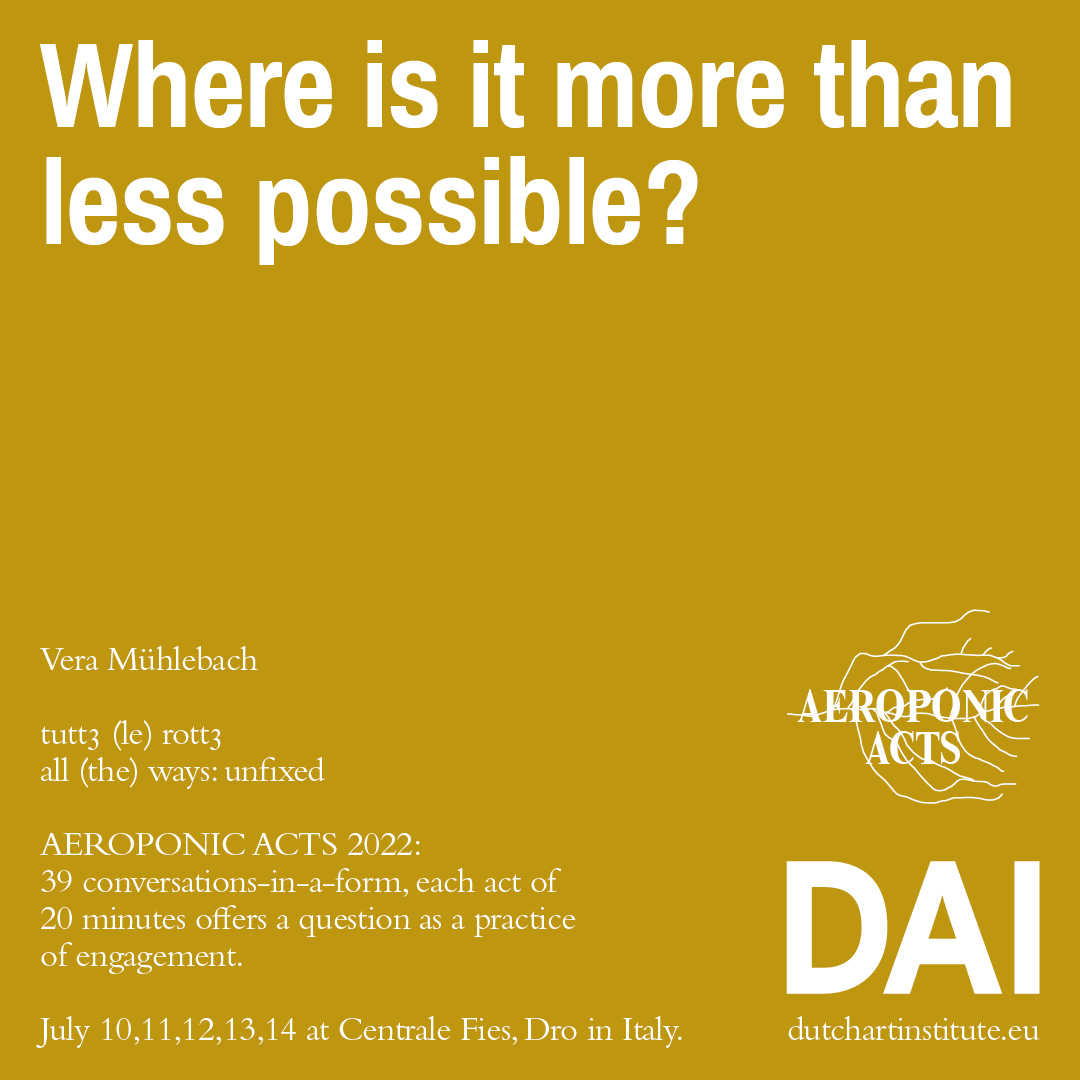Vera Mühlebach: Untitled (Loc. Fies 1 was already taken as a title)
‘Aeroponic’ – root systems nourished by air – Acts is the name given to the nomadic Dutch Art Institute’s final Kitchen presentations. Each participant addresses one question, as a practice of engagement.
Here you will find the documentation of Vera Mühlebach's presentation as filmed by Baha Görkem Yalım. The written report is by Hubert Gromny and it includes a summary of the comments by esteemed guest respondents.
Untitled (Loc. Fies 1 was already taken as a title)
Vera's question: Where is it more than less possible?
Vera's introduction: The performance starts when looks are shifting out of the window and ends when the room is at its openest. Its layers are
the space Sala Comando, Centrale Fies and Trentino
the production of electricity, art and value
you and us and me and we
work, performance and the circulation of air.
“I entered this room for the first time on the 26th. In the middle stood a piano and a chair, inviting to sit down and start playing. I heard music and realized that the piano was uncomfortably out of tune.”
Hubert's report: The performance does not have a distinct starting point. The audience arrives in a bright spacious room with big windows where subtle interventions are applied. The glass of windows is used as a surface for the text, some of which are printed, some handwritten. The letters permeate with the flickering leaves of the background, making the reading fragmentary and affected by the space outside. Some chairs are facing the windows allowing the audience to sit in front of the text. In the middle of the room long ropes beaded with oblong pieces of red and white plastic are placed. Vera is present in the space, at moments takes one of the red-white lines, walks towards the window, opens it and uses the rope to secure that it will remain open. She repeats this action during the performance a few times without any regular pattern. In a similar way—without any regularity—Vera is giving away plums and handouts with printed texts (the same as ones on windows). The space is quiet. There is a drought in the room, which intensifies with the opening of each window. After opening the doors and using the last rope the performance ends.
Momtaza Mehri described the experience of walking in the room and sitting down to read the texts as an immersion in the modality of the presentation, which incorporated the room as its own part and invited participation in a very open way. The subtle way of involving the space into the piece allowed participants to reflect on its broader history. As such the piece opened a way to think of the relationship between Centrale Fies and everything that is outside of its building—as such the piece evoked an experience of dislocation. Momtaza commented on the concept of soft arrangements as a significant intervention into thinking through labor. The air circulating in the room extended connectedness to the outside, bringing forth the totality of histories of social orders, contexts and roles. Facing totality demands to make a ground and pose the question of how these overarching systems determine desires. Momtaza mentioned the poet Kim Moore to think of the lines of a text as a landscape and the particular desires which drive each of these lines.
Ana Teixeira Pinto observed that the piece was built on the interplay and exchange between interiority and exteriority. By the emphasis on relationship between inside and outside the performance alluded to the idea of a text as a stream of consciousness. Ana referred to the novel by Laurence Sterne “The Life and Opinions of Tristram Shandy” as an early model of stream of consciousness as a narrative strategy. The emergence of a sentimental novel in the 18th century was triggered by the need of inventing a bourgeoisie space, which would reflect on domestic space, a space of intimacy, but also a mental space of interiority. Stream of consciousness situated on the threshold between focus (attention to the most miniscule details) and unfocus (lack of attention to the violence of colonialism) was a way allowing bourgeoisie to flee from the awareness of the brutality and violence inflicted by the expansion of the colonial empire. Upper classes needed to create a buffer between themselves and the world, and they populated this intermediary space with sentimentality, streams of small opinions, minute fascinations and interests. By directing attention to the site the piece pointed to the feedback loop between industrialization and imperialism, as the building of Centrale Fies is a remnant of efforts inscribed in larger world economies.
Chiara Figone spoke about the place where Centrale Fies is located and the history of the region. Chiara referred to Gloria Anzaldúa in order to look at the piece through the notions of borderlands and of invoking arts. The gesture of opening the windows, in this perspective, was pointing towards the region, which historically is situated on the borderlands and shaped by shifting frontiers of larger political entities. The ephemeral character of the work was close to the idea of invoking art, which moves away from Western canon in which art has to be materialized as an object or more broadly as a clearly delimited piece. The series of gestures conducted during the performance, proposed another materiality of the work, which was calling attention to what is already there—excavating and problematizing different aspects of Centrale Fies and opening to think of relations which exceeds it.
Vera Mühlebach's "Untitled (Loc. Fies 1 was already taken as a title)" was presented before live audience at the Centrale Fies, Dro, Italy on July 11th.
Find the overview of all 24 AEROPONIC ACTS 2022 here: tuttə (le) rottə - all (the) ways: unfixed


